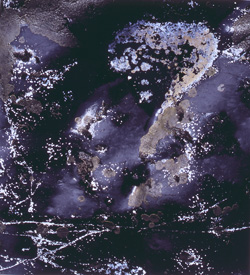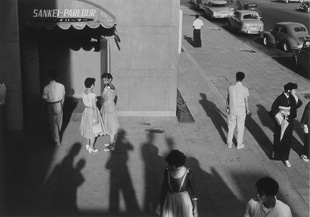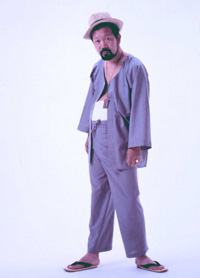 |
Focus features two in-depth reviews each month of fine art, architecture and design exhibitions and events at art museums, galleries and alternative spaces around Japan. The contributors are non-Japanese art critics living in Japan. |
|
|
 |
 |
 |
Shomei Tomatsu: A Slight Distance
Roger McDonald
|
 |
 |
 |
Interface (27),
Oshika Peninsula, 1994 |
|
If you have lived for any extended period of time in Japan over the last five years or so you would undoubtedly have noticed that a resurgence of all things "Showa" is underway. Showa signifies the long period of reign under Emperor Hirohito, encompassing the momentous and traumatic times of World War Two, national recovery and economic expansion, ending with the Emperor's death in 1989. This period has recently featured in a number of novels, films and television dramas as a time of stable values, community ties and a certain innocence. As with most tendencies of looking back, a strong dose of nostalgia and sentimentality accompanies this resurgence.
Shomei Tomatsu is a photographer whose varied work since the 1950s has captured the myriad complexities of this period. His exhibition at the Tokyo Metropolitan Museum of Photography is titled "Tokyo Mandala," the fifth manifestation of his Mandala series, which has so far oriented itself via Nagasaki, Okinawa, Kyoto and Aichi. In short, this exhibition exposes the underbelly of Japan's postwar recovery and growth, providing a much needed counter-narrative to the well worn nostalgia generated by the mass media. Tomatsu's photographs are not grand in scale. They emanate a sense of modernist formality and composure -- staying clear of the grainy blurred razor-like images of his contemporaries such as Daido Moriyama. His photographs exude a painterly air, seeming to combine a reductivist tendency with an interest in highly sharp compositions which often lean towards witty or surreal observations. Tomatsu has spoken of the significant influence of surrealism on his work.
The exhibition opens with photographs taken in the early 1950s. I am familiar with this time in Tokyo through the stories told to me by my father, who arrived in Tokyo as a young businessman in 1950. Tomatsu's images seemed to provide a visual reality to my imaginings of this time. He captures a Tokyo which is in the midst of shaking off its recent wartime experiences and moving headlong into all of the distractions and marvels of modernity.
His reportage works of the 1960s depicting U.S. military bases in Iwakuni and Yokosuka provide evocative historical material in light of current debates about the U.S.-Japan Security Treaty. Tomatsu's images of the protests against military bases are particularly striking, leading into his series of images of student riots in 1969. One picture, taken at night, shows blurred figures silhouetted against wet roads and throwing rocks and missiles, reminiscent of similar images of the May 1968 student riots in Paris. The intense energies of opposition within Japanese society during this time effectively fade out with the spectacle of the Osaka Expo in 1970. Tomatsu includes one image from the Expo showing a futuristic looking escalator moving the masses upwards passed white domes -- all seems cleansed and antiseptic after the fury of the street protests of the late 1960s.
I was also interested in Tomatsu's pictures of environmental destruction during the postwar economic boom. Taken mostly in the 1970s and 1980s, they show us plastic objects washed up on beaches and tall factory chimneys rising behind ancient gravestones on mountains. He seems interested in the discarded and abject aspects of modernity, sharing a concern of many people associated with surrealism such as Georges Bataille, who also focused on leftovers and on dust. Parallel to these studies are his images of what one can call an "old Japan" -- talismans and the women shamans of Mount Osore. These photographs seem to suggest another historical time or space, different from that of modernizing processes in the urban centers.
Although Tomatsu is well known both within and outside Japan, this exhibition brings together a significant number of his Tokyo images for the first time. It provides a broad context within which to judge his stance as a photographer and social witness. The exhibition culminates with a series of seemingly charming images of cherry blossoms in various locations near Tokyo. Tomatsu's camera breaks out of its earlier black and white mode of reportage and embraces the colorful but rather lackluster reality of these traditional symbols of Japanese culture as emptied signs of an ever-pervasive consumerism.
 |
 |
 |
Fashion,
Tokyo, 1955 |
 |
Photographer (4),
Shomei Tomatsu, 1978 |
|
 |
 |
 |
Roger McDonald
Roger McDonald was born and brought up in Tokyo, educated in the UK, and returned to live in Japan in 2000 after completing his PhD. He has worked on the Yokohama Triennale 2001 as assistant curator, the Singapore Biennale 2006 as curator, and organised a number of exhibitions and projects independently. He is deputy director of the non-profit curatorial collective Arts Initiative Tokyo, and teaches at Musashino and Tama Art Universities. |
|
 |
|